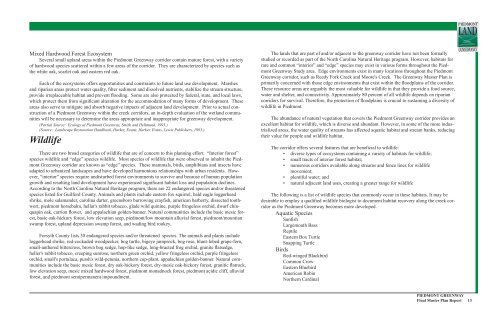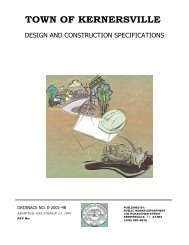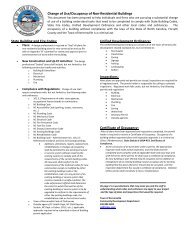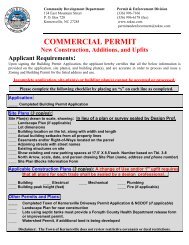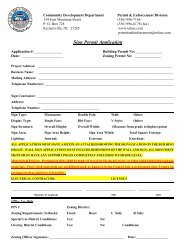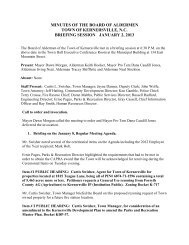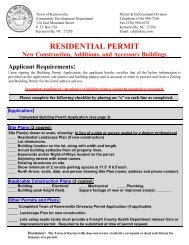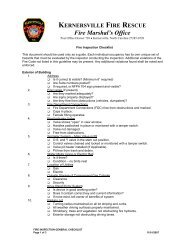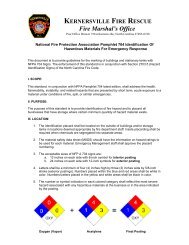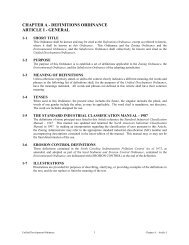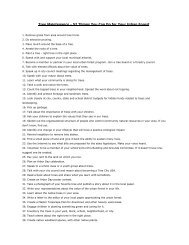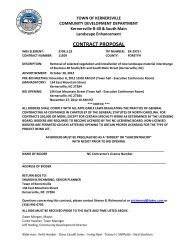Piedmont Greenway Master Plan - Town of Kernersville
Piedmont Greenway Master Plan - Town of Kernersville
Piedmont Greenway Master Plan - Town of Kernersville
- No tags were found...
You also want an ePaper? Increase the reach of your titles
YUMPU automatically turns print PDFs into web optimized ePapers that Google loves.
Mixed Hardwood Forest Ecosystem<br />
Several small upland areas within the <strong>Piedmont</strong> <strong>Greenway</strong> corridor contain mature forest, with a variety<br />
<strong>of</strong> hardwood species scattered within a few areas <strong>of</strong> the corridor. They are characterized by species such as<br />
the white oak, scarlet oak and eastern red oak.<br />
Each <strong>of</strong> the ecosystems <strong>of</strong>fers opportunities and constraints to future land use development. Marshes<br />
and riparian areas protect water quality, filter sediment and dissolved nutrients, stabilize the stream structure,<br />
provide irreplaceable habitat and prevent flooding. Some are also protected by federal, state, and local laws,<br />
which protect them from significant alteration for the accommodation <strong>of</strong> many forms <strong>of</strong> development. These<br />
areas also serve to mitigate and absorb negative impacts <strong>of</strong> adjacent land development. Prior to actual construction<br />
<strong>of</strong> a <strong>Piedmont</strong> <strong>Greenway</strong> within the creek corridors, an in-depth evaluation <strong>of</strong> the wetland communities<br />
will be necessary to determine the areas appropriate and inappropriate for greenway development.<br />
(Partial Source: Ecology <strong>of</strong> <strong>Piedmont</strong> <strong>Greenway</strong>, Smith and Hellmund, 1993.)<br />
(Source: Landscape Restoration Handbook, Harker, Evans, Harker, Evans, Lewis Publishers, 1993.)<br />
Wildlife<br />
There are two broad categories <strong>of</strong> wildlife that are <strong>of</strong> concern to this planning effort. “Interior forest”<br />
species wildlife and “edge” species wildlife. Most species <strong>of</strong> wildlife that were observed to inhabit the <strong>Piedmont</strong><br />
<strong>Greenway</strong> corridor are known as “edge” species. These mammals, birds, amphibians and insects have<br />
adapted to urbanized landscapes and have developed harmonious relationships with urban residents. However,<br />
“interior” species require undisturbed forest environments to survive and because <strong>of</strong> human population<br />
growth and resulting land development have experienced significant habitat loss and population declines.<br />
According to the North Carolina Natural Heritage program, there are 22 endangered species and/or threatened<br />
species listed for Guilford County. Animals and plants include eastern fox squirrel, bald eagle loggerhead<br />
shrike, mole salamander, carolina darter, greensboro burrowing crayfish, american barberry, dissected toothwort,<br />
piedmont horsebalm, hellar's rabbit tobacco, glade wild quinine, purple fringeless orchid, dwarf chinquapin<br />
oak, carrion flower, and appalachian golden-banner. Natural communities include the basic mesic forest,<br />
basic oak-hickory forest, low elevation seep, piedmont/low mountain alluvial forest, piedmont/mountian<br />
swamp forest, upland depression swamp forest, and wading bird rookey.<br />
Forsyth County lists 30 endangered species and/or threatened species. The animals and plants include<br />
loggerhead shrike, red-cockaded woodpecker, bog turtle, bigeye jumprock, bog rose, blunt-lobed grape-fern,<br />
small-anthered bittercress, brown bog sedge, hop-like sedge, long-bracted frog orchid, granite flatsedge,<br />
heller's rabbit tobacco, creeping sunrose, northern green orchid, yellow fringeless orchid, purple fringeless<br />
orchid, small's portulaca, pursh's wild-petunia, northern cup-plant, appalachian golden-banner. Natural communities<br />
include the basic mesic forest, dry oak-hickory forest, dry-mesic oak-hickory forest, granitic flatrock,<br />
low elevation seep, mesic mixed hardwood forest, piedmont monadnock forest, piedmont acidic cliff, alluvial<br />
forest, and piedmont semipermanent impoundment.<br />
The lands that are part <strong>of</strong> and/or adjacent to the greenway corridor have not been formally<br />
studied or recorded as part <strong>of</strong> the North Carolina Natural Heritage program. However, habitats for<br />
rare and common “interior” and “edge” species may exist in various forms throughout the <strong>Piedmont</strong><br />
<strong>Greenway</strong> Study area. Edge environments exist in many locations throughout the <strong>Piedmont</strong><br />
<strong>Greenway</strong> corridor, such as Reedy Fork Creek and Moore's Creek. The <strong>Greenway</strong> <strong>Master</strong> <strong>Plan</strong> is<br />
primarily concerned with those edge environments that exist within the floodplains <strong>of</strong> the corridor.<br />
These resource areas are arguably the most valuable for wildlife in that they provide a food source,<br />
water and shelter, and connectivity. Approximately 80 percent <strong>of</strong> all wildlife depends on riparian<br />
corridors for survival. Therefore, the protection <strong>of</strong> floodplains is crucial to sustaining a diversity <strong>of</strong><br />
wildlife in <strong>Piedmont</strong>.<br />
The abundance <strong>of</strong> natural vegetation that covers the <strong>Piedmont</strong> <strong>Greenway</strong> corridor provides an<br />
excellent habitat for wildlife, which is diverse and abundant. However, in some <strong>of</strong> the more industrialized<br />
areas, the water quality <strong>of</strong> streams has affected aquatic habitat and stream banks, reducing<br />
their value for people and wildlife habitat.<br />
The corridor <strong>of</strong>fers several features that are beneficial to wildlife:<br />
• diverse types <strong>of</strong> ecosystems containing a variety <strong>of</strong> habitats for wildlife;<br />
• small tracts <strong>of</strong> interior forest habitat;<br />
• numerous corridors available along streams and fence lines for wildlife<br />
movement;<br />
• plentiful water; and<br />
• natural adjacent land uses, creating a greater range for wildlife<br />
The following is a list <strong>of</strong> wildlife species that commonly occur in these habitats. It may be<br />
desirable to employ a qualified wildlife biologist to document habitat recovery along the creek corridor<br />
as the <strong>Piedmont</strong> <strong>Greenway</strong> becomes more developed.<br />
Aquatic Species<br />
Sunfish<br />
Largemouth Bass<br />
Reptile<br />
Eastern Box Turtle<br />
Snapping Turtle<br />
Birds<br />
Red-winged Blackbird<br />
Common Crow<br />
Eastern Bluebird<br />
American Robin<br />
Northern Cardinal<br />
PIEDMONT GREENWAY<br />
Final <strong>Master</strong> <strong>Plan</strong> Report 13


